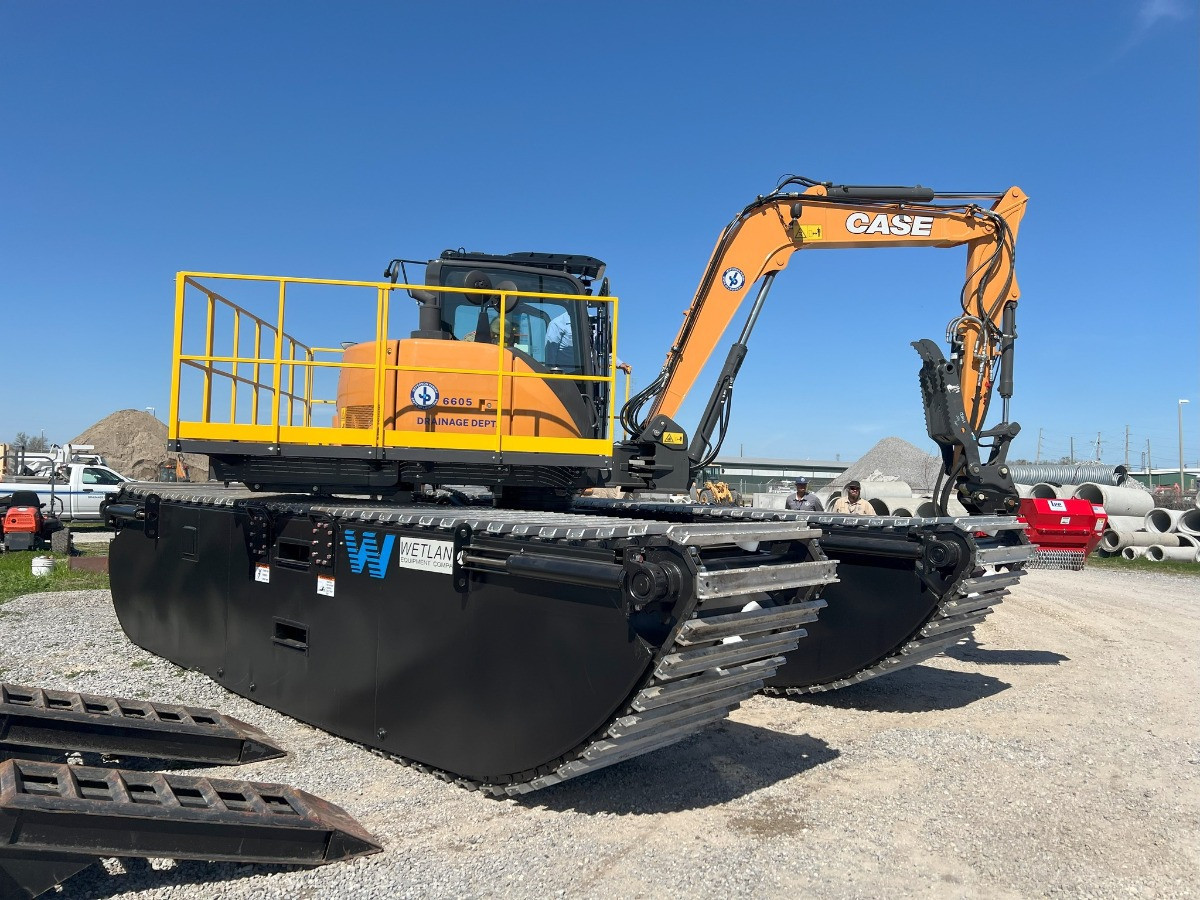
How to Select the Right Size Amphibious Excavator
SELECTING THE RIGHT SIZE AMPHIBIOUS EXCAVATORS
Wetland Equipment is a leader in the manufacturing and supply of amphibious excavators, offering innovative solutions for challenging wetland and aquatic environments. Selecting the right size amphibious excavator is crucial for the success of any project. Whether you are involved in dredging, swamp reclamation, or pipeline construction, the efficiency and safety of your operations depend significantly on choosing an excavator that matches the specific needs of your project.
Understanding Amphibious Excavators
Amphibious excavators are specialized machines designed to operate efficiently in environments where traditional excavators would struggle. These excavators are equipped with pontoons, which allow them to float and navigate through waterlogged terrains, such as swamps, marshes, and shallow waterways. Unlike traditional excavators, which are limited to dry land or require extensive modifications to work in wet conditions, amphibious excavators are purpose-built for versatility in both aquatic and terrestrial environments. They are commonly used for dredging operations, swamp reclamation projects, flood control efforts, and pipeline construction in challenging, wet landscapes.
One of the primary distinctions between amphibious and traditional excavators is their ability to perform in soft, unstable terrains without the risk of sinking or becoming stuck. Amphibious excavators are designed with wide tracks and pontoons, providing enhanced buoyancy and stability. This design allows them to traverse difficult terrains where standard excavators would face significant operational challenges. Their adaptability makes them an invaluable asset for a wide range of applications in wetland environments, from environmental conservation projects to industrial operations. Understanding these unique characteristics is fundamental when selecting the right size excavator for your specific needs, ensuring that the machine can handle the demands of your project while maintaining efficiency and safety.
Key Factors to Consider When Selecting the Size
When choosing the right size amphibious excavator for your project, several critical factors must be taken into account to ensure optimal performance and safety.
Project Scope and Requirements: The scale and complexity of your project are primary considerations. For small-scale operations such as minor dredging or light construction, a mini amphibious excavator may suffice. However, large-scale projects like extensive swamp reclamation or significant construction undertakings will demand more robust, larger-sized machines with higher capabilities.
Site Conditions: Understanding the specific conditions of the work site is crucial. Factors such as the depth of water, type of terrain, and soil consistency play a significant role in determining the appropriate excavator size. For instance, deeper waters and softer soils may require larger excavators with enhanced stability and reach to perform efficiently without the risk of getting stuck.
Excavator Specifications: The technical specifications of the excavator, including engine power and hydraulic capabilities, are vital in matching the machine to the project needs. A higher horsepower engine and stronger hydraulics enable the excavator to handle more demanding tasks and heavier loads. Additionally, considering the reach and digging depth of the excavator ensures it can perform the required tasks effectively.
Load Capacity and Stability: The load capacity and stability of an amphibious excavator are essential for maintaining safety and efficiency in waterlogged conditions. Ensuring the excavator can handle the anticipated load without compromising its buoyancy and stability is crucial. Overloading an undersized machine can lead to operational hazards and inefficiencies.
Size Categories of Amphibious Excavators
Amphibious excavators come in various sizes, each suited to different types of projects and operational requirements. Understanding the size categories helps in selecting the right machine for your specific needs.
Mini Amphibious Excavators: These are ideal for small-scale projects and tight spaces. Mini amphibious excavators are perfect for tasks that require maneuverability in confined areas, such as small dredging operations or minor construction projects. Their compact size allows them to access areas that larger machines cannot, making them highly versatile. However, their smaller size also means they have lower load capacities and reach, limiting their use to lighter tasks.
Mid-sized Amphibious Excavators: Offering a balance between versatility and power, mid-sized amphibious excavators are well-suited for medium-sized projects. These machines provide greater reach and load capacity compared to mini excavators, making them ideal for a broader range of applications, such as moderate dredging, wetland restoration, and construction projects. They offer enhanced performance while maintaining maneuverability in various terrains.
Large Amphibious Excavators: These are designed for extensive, heavy-duty operations. Large amphibious excavators boast the highest load capacities, engine power, and hydraulic strength, making them suitable for large-scale projects like extensive swamp reclamation, major dredging operations, and significant infrastructure construction. Their robust design allows them to handle the most challenging conditions and demanding tasks, ensuring efficiency and productivity on a grand scale.
Matching Excavator Size to Project Needs
Selecting the right size amphibious excavator is not just about understanding specifications and categories; it’s about aligning the machine’s capabilities with the specific needs of your project. This process can be greatly enhanced by examining real-world case studies and seeking expert advice.
Case Studies and Examples: Reviewing case studies of different-sized amphibious excavators in action can provide valuable insights into their performance in various scenarios. For example, a small-scale wetland conservation project might benefit from a mini amphibious excavator due to its ability to navigate tight spaces and its minimal environmental footprint. Conversely, a large-scale dredging operation in a deep, expansive swamp may require the robust capabilities of a large amphibious excavator to handle heavy loads and extensive reach. These examples illustrate how different projects necessitate different sizes and capabilities, highlighting the importance of selecting the appropriate excavator size for your specific operational needs.
Consultation with Experts: The complexity of selecting the right amphibious excavator can be mitigated by consulting with industry experts. Professionals at Wetland Equipment can provide tailored advice based on their extensive experience and knowledge. By understanding the unique requirements of your project, they can recommend the most suitable excavator size, ensuring that you achieve maximum efficiency and safety. Engaging with experts early in the planning stages can prevent costly mistakes and optimize project outcomes, making expert consultation a valuable step in the selection process.
Additional Considerations
Beyond the fundamental factors of project scope, site conditions, and machine specifications, several additional considerations play a crucial role in the selection of an amphibious excavator.
Transport and Logistics: Moving an amphibious excavator to and from the project site requires careful planning and coordination. Larger excavators may necessitate specialized transport equipment and permits due to their size and weight. Understanding the logistical challenges associated with transporting different sizes of excavators ensures that your project timeline remains on track and that the machine arrives safely and on schedule.
Maintenance and Support: Ensuring the availability of maintenance services and spare parts is essential for minimizing downtime and maintaining operational efficiency. Larger excavators may require more frequent maintenance due to their increased workload, and access to reliable service providers can significantly impact project continuity. Partnering with a supplier like Wetland Equipment, which offers comprehensive support and maintenance services, can provide peace of mind and operational reliability.
Environmental Impact: The ecological footprint of your excavation project is a critical consideration, especially in sensitive wetland environments. Choosing the right size excavator can help minimize environmental disruption. Smaller excavators may have less impact on the surrounding ecosystem, making them preferable for projects with stringent environmental regulations. Additionally, adopting best practices for operating in wetland areas can further reduce the ecological impact, ensuring that your project aligns with environmental sustainability goals.
Get the Best Amphibious Excavators for Sale Today
For expert guidance in selecting the ideal amphibious excavator for your project, contact Wetland Equipment today. Our team of experienced professionals is ready to assist you in evaluating your project requirements and recommending the best excavator size to meet your specific needs. With our extensive range of amphibious excavators and comprehensive support services, we ensure your project runs smoothly and efficiently from start to finish.

